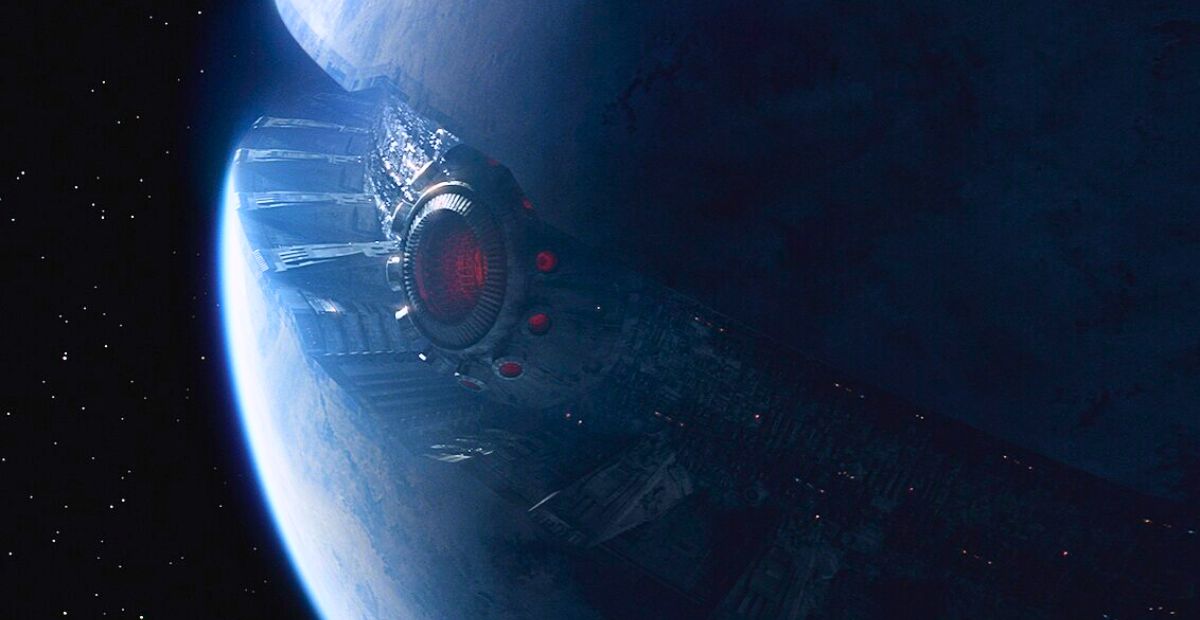When The Force Awakens introduced Starkiller Base, it was meant to raise the bar beyond the Death Star. A weapon built into a planet that could drain a star and fire across the galaxy to destroy entire systems. On screen, it looked like the most powerful thing Star Wars had ever shown. But once you start looking deeply into how it’s supposed to work, it quickly falls apart—both scientifically and in-universe. Let’s break down why.
1. Draining a Star Should Break Everything Around It—and Possibly Turn You Into a Star
Starkiller Base doesn’t just destroy a planet. It destroys multiple planets in different systems from across the galaxy—by draining the energy of a nearby star. The logic seems simple: convert star energy into a laser, fire it through hyperspace, and wipe out your enemies. But both real science and Star Wars lore say this shouldn’t work at all.
Astrophysicist Neil deGrasse Tyson pointed out a major flaw: if you take in all the energy from a star, you essentially become a star. The energy inside a star is so massive that storing it would either ignite the object or require a containment system far beyond anything shown in the film. According to Tyson’s calculation, the energy of one star could destroy not just five planets—but thousands. That means Starkiller Base underuses its stolen power. And if that much energy really was absorbed, the planet itself should have been incinerated or turned into another star.
On top of that, removing a star from a solar system completely breaks that system’s gravitational balance. Planets and moons would drift off or collapse. Hyperspace lanes would destabilize, since in Star Wars, hyperspace travel depends on predictable gravitational routes. In The High Republic series, we’ve seen how delicate those routes are—even a single incident can cause galactic-wide rerouting. Yet none of that happens in the movie.
2. It’s So Powerful That It Breaks the Story
Narratively, Starkiller Base is a dead end. It’s introduced to raise the stakes beyond what the Death Star did, but it overshoots. If the First Order has a weapon that can wipe out entire systems from across the galaxy, there’s no real reason for any further conflict. The Resistance shouldn’t be fighting in space skirmishes—they should be wiped out instantly.
Worse, the weapon’s consequences never show up again. The Hosnian system, home to the New Republic’s capital, is erased. But there’s no mourning, no strategic fallout, and no deeper discussion. It’s barely mentioned in The Last Jedi or The Rise of Skywalker. That kind of world-shaking event is brushed aside, leaving the audience to wonder why it was even included.
If the story had followed through—if the destruction of the Republic had shifted the galaxy’s balance of power, or if Starkiller Base had become a long-term threat—it might’ve worked. Instead, it’s just another Death Star, but louder.
3. The Star Forge Did the Same Concept Better—and with More Depth
Long before Starkiller Base, Legends already had a superweapon that drew energy from a star—and it made far more sense. The Star Forge, introduced in Star Wars: Knights of the Old Republic, was a massive automated shipyard created by the Rakatan Infinite Empire around 30,000 BBY. It used the power of a nearby star (Abo in the Lehon system) not to destroy, but to build: warships, droids, and weapons.
What made it especially believable was how it worked. The Star Forge drew off the star’s plasma and matter slowly over time, not all at once. It didn’t destabilize the system. Instead, it combined that stellar energy with the dark side of the Force, turning itself into a near-living, semi-sentient tool of conquest. It could sustain itself for thousands of years, remaining active even without a crew. And its output—an infinite supply of military material—was directly tied to how much dark side energy its users fed into it.
The Star Forge also had real consequences. Its dark side influence corrupted both the Rakata and later Sith like Darth Malak. Revan, even after turning to the light side, had to avoid overusing it. In the story, it eventually caused the collapse of the Rakatan Empire itself. The weapon had lore depth, long-term effects, and strategic balance.
By contrast, Starkiller Base feels like a simplified version of that same idea, stripped of nuance. It takes in more energy than the Star Forge ever did, but for a single, destructive purpose. No sustainability. No balance. No real explanation for how it avoids the natural consequences of what it’s doing.
Fun Fact: Starkiller Base Is Much Smaller Than the Moon
Despite its planet-killing powers, Starkiller Base is only around 660 kilometers in diameter. That makes it smaller than Earth’s moon (3,474.8 kilometers). Yet somehow, it’s supposed to store or channel the energy of a star without collapsing in on itself. That’s one of the strangest scaling problems in all of Star Wars.

